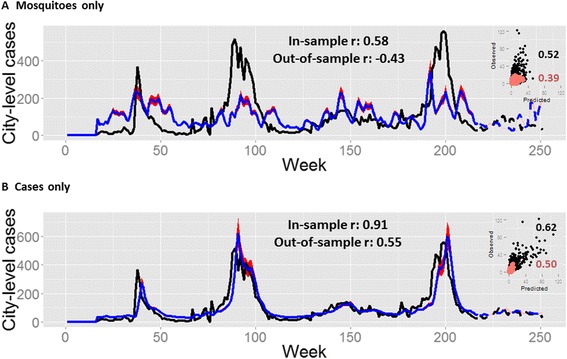Figure 3.

City-level summary of model fits for Vitoria. The best model with only mosquito covariates, M i and ∑ j M j, (A) is compared to the best model with only dengue-case covariates, Y i and ∑ j (Y j f(x j )) (B). Models were fitted using neighborhood-level data but aggregated to the city level for presentation. Goodness-of-fit was calculated as the Spearman’s correlation (r) between the observed and model-predicted values for the fitted model (“In-sample”, solid lines) and out-of-sample predictions (dashed lines). Correlation coefficients are presented for both the aggregated city-level data (main plots) and for the neighborhood-level results presented in the scatterplot insets. Observed data (black lines; solid: in-sample, dashed: out-of sample); model predictions (blue lines; solid: in-sample, dashed: out-of sample), 97.5% credible intervals (red shades: in-sample; pink shades: out-of-sample). (A) Y i,t = β 1 M i,t-13 + β 2∑j M j,t-12 0.1 + log(P i) + π i (B) Y i,t = β 1 Y i,t-1 + β 2∑j(Y j,t-1 /d ij ) 0.5 + log(P i) + π i; only the best Y j term is presented (although they are all similar). For both models, the best lag and scale terms were included as indicated (lag terms are a mean from a 3-week window, e.g., 13 represents the mean for weeks 13–15). Y are cases, M are mosquitos, P is population size, π is the neighborhood random effect, t is the week, i is the target neighborhood and j are the sum of all other neighborhoods that are not i.
